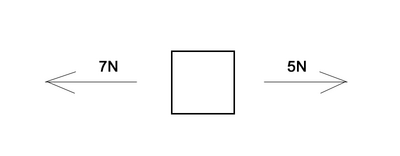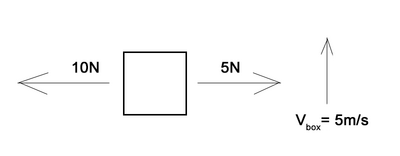Newton’s First Law of Motion
CLAIMED BY KEVIN TIAN :)

Newton's First Law of Motion, commonly referred to as the law of inertia, explains the relationship between the the change of velocity of an object and its interaction with others.
The Main Idea
To be exact, the definition of the First Law of Motion is as follows:
Every body persists in its state of rest or of moving with constant speed in a constant direction, except to the extent that it is compelled to change that state by forces acting on it.
In other (and much simpler) terms, it means that an object at rest stays at rest and an object in in motion stays in motion at a constant velocity unless acted on by an unbalanced net force. It's important to keep in mind that only a difference in net force can affect the velocity of an object. The amount of change in velocity is determined by Newton's Second Law of Motion.
A Mathematical Model
Newton's first law can be stated mathematically as follows:
[math]\displaystyle{ {\vec{F_{net}} = 0 \Leftrightarrow \frac{d\vec{v}}{dt}} = 0 }[/math]
Where...
[math]\displaystyle{ \vec{F_{net}} }[/math] is the net force from the surroundings.
[math]\displaystyle{ d\vec{v} }[/math] is the change in velocity of the system.
[math]\displaystyle{ dt }[/math] is the change in time of the system
If we trace this formula from the left to the right, we can see that if the net force on an object is zero, then the change in velocity of an object is also zero. Conversely, if we were given an object and told that its change in momentum is zero, then we can deduce that the net force acting on the object is also zero. Keep in mind, however, that this formula simple deals with the change in velocity. It does not mean that the object is at rest, only that its velocity remains constant.
Examples
The following examples are to test your basic understanding of Newton's First Law. For more examples that test your knowledge of all three of the laws, click here.
Simple
Does the object in the following image have a net force of zero? Does it have a constant velocity?
It's easy to see that the only force on the object is acting in the +x direction, with a magnitude of 5 newtons. Therefore, the object does not have a net force of zero or a constant velocity. It will be accelerating in the +x direction.
Middling
Does the object in the following image have a net force of zero? Does it have a constant velocity?
This example is slightly more difficult, but is still quite trivial. If we sum the forces in the x direction, we see that the net force is 2 newtons in the -x direction. Therefore, the object does not have a constant velocity, and will be accelerating in the -x direction.
Difficult
Does the object in the following image have a net force of zero? Does it have a constant velocity?
This final example tests your knowledge and understanding of Newton's First Law. We're able to see that the box will accelerate in the -x direction because the net force in the x direction is 5 newtons to the left. However, the box itself has a velocity of 5m/s upwards, which would indeed stay constant. This is because forces (and motion) in perpendicular directions are independent of each other.
Connectedness

Newton's laws of motion tie into almost everything that we see or do. The first law, in particular, explains why we suddenly lurch forward when a car suddenly stops (our bodies are in a state of motion and thus resist the sudden stop), why it's much harder to stop when ice skating than walking (there's less friction, thus less net force to decelerate), and much, much, more. The importance of Newton's first law (and by extension, the other laws of motion) is not readily apparent, but serves as a basis to explain much of our daily interactions with our surroundings.
It can also apply to things outside of our daily interactions - space, for example. Newton's first law describes why an astronaut in space will continuously float in a direction forever if they are not pulled in by an asteroid or a planet's gravitational force. There is a lack of a net force opposing the astronaut's motion (due to the fact that there is no air in space) which results in the astronaut having a constant velocity. Floating off into space is probably an astronaut's worst nightmare, a scenario that a recent movie, Gravity, explored. The entire premise of the movie (Sandra Bullock becomes untethered from her space station) relies on Newton's first law of motion.
History
While Galileo is the one credited with the idea of inertia motion, it was René Descartes, a French philosopher, who would expand upon Galileo's ideas. Descartes went on to propose three fundamental laws of nature in his book, Principles of Philosophy, the first of which stated that "each thing, as far as is in its power, always remains in the same state; and that consequently, when it is once moved, it always continues to move." Thus, while the concept of inertia is often referred to as Newton's First Law, it was first described by Galileo and then perfected by Descartes decades before Newton published his findings.
As for Newton, he first described his three laws of motion in The Mathematical Principle of Natural Philosophy, for the Principia, which was published in 1687. These laws described the relationship between an object and the forces acting upon it and laid the foundation for classical mechanics. While Newton's first law came from the work of Descartes and Galileo, his other laws are the work of himself.
See also
External links
- Light and Matter - an online physics textbook.
References
- Crowell, Benjamin (2011), Light and Matter (2011, Light and Matter), especially at Section 4.2, Newton's First Law.
- Chabay, Ruth W., and Bruce A. Sherwood. Matter and Interactions. Hoboken, NJ: Wiley, 2011. Print.
- Henderson, Tom. "Newton's First Law." The Physics Classroom. Web. 2 Apr. 2016.


